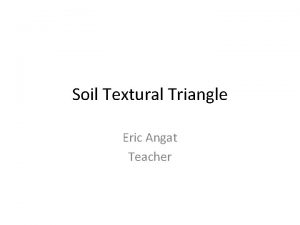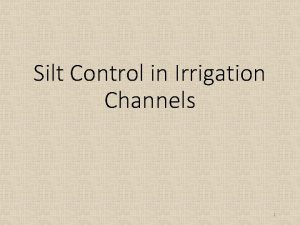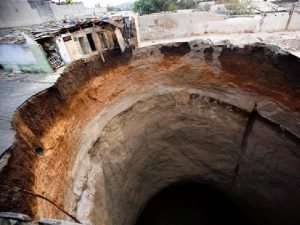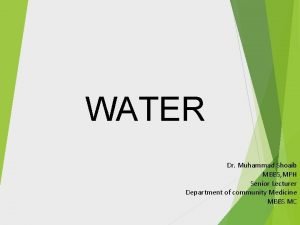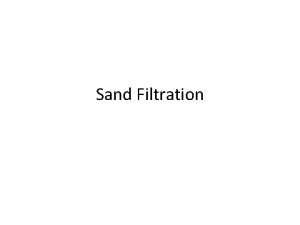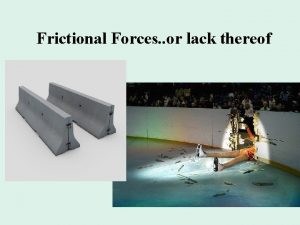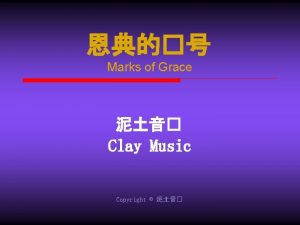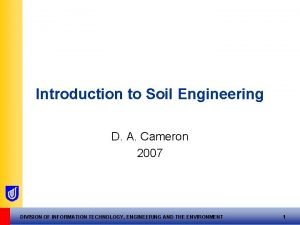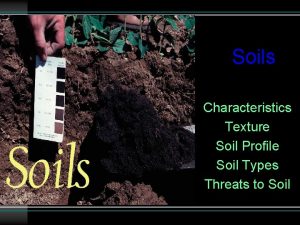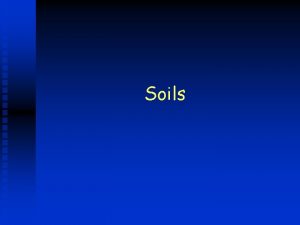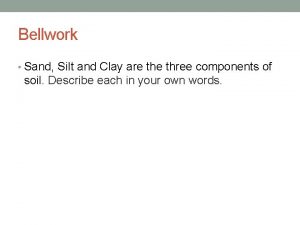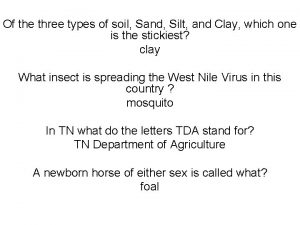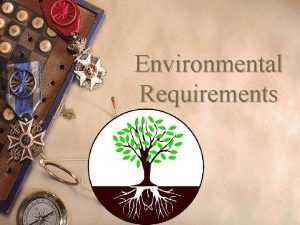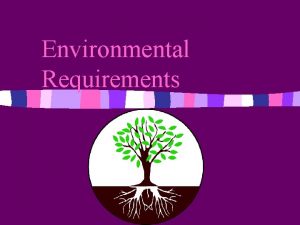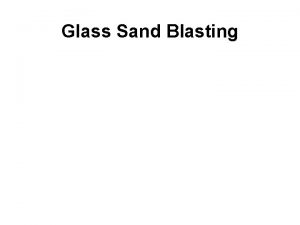Soils Soil components Clay Silt Sand The clay











- Slides: 11

Soils

Soil components – Clay, Silt, Sand The clay particle is a dot on the page; the sand is huge in comparison. Sandy soils have spaces between particles and drain readily, are drought prone and nutrient poor. The tiny clay particles tightly packed and therefore clay soils are very dense. Clay soils are more nutrient rich and moisture retentive, but when they do dry out, tend to be very hard.

Soil Texture triangle The relative amounts of clay, silt and sand determine soil type. Notice that a large portion of the chart refers to clay soils. The presence of clay has a very strong influence on the character of the soil. It only takes about 20 % clay particles for a soil to behave as a clay soil. The perfect combination is called loam and consists of • 40% sand • 40% silt

Typical Soil Profile Soil layers are called “Horizons” O Horizon (Organic matter): Leaf litter and other biological material that has not decmposed. A Horizon (Topsoil): Layer of mineral soil with organic matter. This is where the action is – earthworms, fungi and other microbes that decompose organic matter, and , hopefully, lots of plant roots. This layer is sometimes missing in urban soils. B Horizon (Subsoil): This layer contain the finer particles (often clay) that have washed down from above and contains minerals (iron, aluminum , calcium , etc) ; mineral content will vary depending on the site. C Horizon (Parent rock): Layer of large unbroken This is the simple version of soil horizons. Soil scientists have much more rocks. detailed versions with additional categories and subdivisions within categories. The image is from Wikipedia

Simple ways to determine soil type Feel test – Rub some moist soil between fingers. • Sand feels gritty. • Silt feels smooth. • Clays feel sticky. Ball squeeze test – Squeeze a moistened ball of soil in the hand. • Coarse texture soils (sand or loamy sands) break with slight pressure. • Medium texture soils (sandy loams and silt loams) stay together but change shape easily. • Fine textured soils (clayey or clayey loam) resist breaking / don’t change shape Texture test - Mix soil and water in a jar and measure layers of sediment (sand, silt, clay) to determine proportions Ribbon test – clay soils will form a ribbon The above information is from http: //www. ext. colostate. edu/mg/gardennotes/214. html Directions for all of the above can be found at that site.

Ribbon Test Moisten a handful of soil and knead to a consistent texture. (The test will not work if too much water is added; the goal is a consistently moist, not wet, ball of soil. ) Roll into a cigarette shape and squeeze it between your thumb and forefinger to form the longest and thinnest ribbon possible. Soil with high silt content will form flakes or peel instead of forming a ribbon. The longer and thinner the ribbon, the higher the percentage of clay. The soil pictured here has a long ribbon and therefore a high clay content.

The chart is from http: //www. ext. colostate. edu/mg/gardennotes/214. html Using just water and your hands, you can classify the soil type even further. Follow the instructions on this chart. No tools needed. The soil types here correspond to those on the soil texture triangle.

Soil Probes A soil probe can be used to collect samples for soil testing. Take several samples from the area to be tested, mix together, and send to a lab in a soil sample box. The soil probe can also be used to see the soil profile. Ease of collection can be an indication of compaction: the more difficult it is to insert the probe, the more compact the soil. (Frozen or very dry soils are exceptions. )

Soil profile using the soil probe - About 6 inches of good, loamy soil with heavy clay below. There is a fairly clear distinction between the A and B horizon.

Sections of soil can be removed from the probe for testing.

Summary Determining soil type is easy if you don’t mind getting your hands dirty! You may also need a soil test for nutrient availability and p. H if you plan to apply lime or fertilizers. If you do use chemical fertilizers, do so with caution in sandy soils since they will leach out easily, won’t be available to plants for long and may enter the ground water. Determining soil type is useful before planting. Many trees are very adaptable and tolerate most any soil type. Others have more specific requirements. An example would be trees that require moisture retentive soils; these should not be planted in sandy soils. Knowing the soil type may also help you determine how frequently new plantings should be watered.
 5 provinces of virginia
5 provinces of virginia Types of soil triangle
Types of soil triangle Silt excluder and silt ejector
Silt excluder and silt ejector Difference between sand and clay
Difference between sand and clay Difference between rapid sand filter and slow sand filter
Difference between rapid sand filter and slow sand filter Perbedaan rapid sand filter dan slow sand filter
Perbedaan rapid sand filter dan slow sand filter Friction definition
Friction definition Molding sand
Molding sand Amy sand clay music
Amy sand clay music Cameron 2007
Cameron 2007 Characteristics of loam
Characteristics of loam Transition area between soil and parent material
Transition area between soil and parent material

